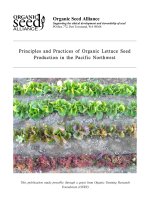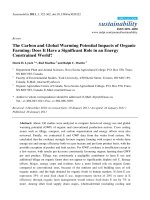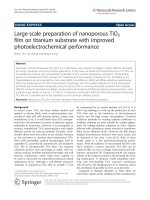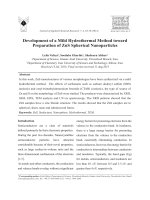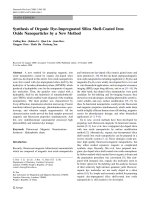Preparation of mesoporous SiO2 and ZnO•SiO2 composite from raw rice husk for removal of organic dye
Bạn đang xem bản rút gọn của tài liệu. Xem và tải ngay bản đầy đủ của tài liệu tại đây (1.49 MB, 7 trang )
Journal of Science & Technology 134 (2019) 037-043
Preparation of Mesoporous SiO2 and ZnO•SiO2 Composite from Raw Rice
Husk for Removal of Organic Dye
Le Tien Dat, Hoang Thi Thu, Nguyen Thi Van, Vu Anh Tuan*
Hanoi University of Science and Technology – No. 1, Dai Co Viet Str., Hai Ba Trung, Ha Noi, Viet Nam
Received: October 26, 2018; Accepted: June 24, 2019
Abstract
Mesoporous SiO2 and ZnO•SiO2 composite (10 wt.% of SiO2) were prepared from rice husk for removal of
organic dye (Janus Green B, JGB). As-prepared samples were characterized by XRD, FE-SEM, FT-IR, and
N2 adsorption/desorption isotherms. SiO2 was observed as mesoporous material with large surface area (98.2
m2/g) and high pore volume (0.746 cm3/g). However, these values were significantly decreased when ZnO
doped in ZnO•SiO2 composite. The performance of SiO2 was evaluated by adsorption of JGB and performance
of ZnO•SiO2 composite was evaluated by photo-degradation of JGB under low UV intensity (8 W). The
adsorption capacity of SiO2 was 3379.5 mg/g and adsorption rate was 0.062 min-1. The degradation efficiency
of JGB on ZnO•SiO2 composite was 97.9% in 60 min and degradation rate was 0.061 min-1.
Keywords: Photo-degradation, Zinc Oxide, Mesoporous Silica, Rice Husk, Janus Green B
1. Introduction
Industrial1 wastewater can contain a wide range
of pollutants such as organic compounds and heavy
metals. It can have a significant impact on human
health and environmental disasters if it is untreated and
discharged directly into the environment. Industries
must be responsible for ensuring the quality of the
effluent within acceptable standards. However, The
UN World Water Development Report, in many
developing countries, more than 70 percent of
unprocessed industrial waste is discharged into water
sources and contaminated water [1]. The largest
sources of hazardous industrial wastewater come from
mining, pulp mill, textiles, tanning, sugar mills and
pharmaceutical manufacturing [2]. In many cases,
industrial wastewater not only discharges directly but
also infiltrates the ground causing groundwater
contamination and underground wells. Therefore,
industrial effluents need to be treated before being
delivered to the environment.
framework), the catalytic activity and adsorption
capacity could be increased [6-8].
Recently, metal containing mesoporous silica
have attracted much attention because the silica-based
materials have the high surface area, good thermal
stability, and favorable hydrothermal stability.
Numerous iron mesoporous silica composites were
synthesized for degrading organic compounds such as
methyl orange, acid orange, polyarylamide, and
phenol [9-12]. The selection of suitable silica source is
a crucial factor with respect to practical application
because the silica source is directly affected not only
to properties of silica supporters but to cost effective
application. Mesoporous silica synthesized by using
tetraethyl orthosilicate (TEOS) was known as a
relatively expense silica material. In this study, rice
husk (RH), a cheap silica source, was utilized, which
is a by-product from rice mills in enormous quantities.
As an energy source in various industries burning rice
husk generates rice husk ash (RHA) that contains a
high percentage of silica and can be an economically
valuable raw material for production of natural silica.
The semiconductor photocatalysis has emerged
as one of the most promising processes for wastewater
treatment as compared to other conventional
techniques [3]. In which, ZnO with high stability,
photosensitivity, advanced optical properties, and low
cost is an excellent selection for wastewater treatment
process [4,5]. When, ZnO nano particles were
deposited on porous materials such as SiO2, AC
(activated carbon), and MOF (metal organic
In this study, mesoporous SiO2 was prepared
from RH and ZnO•SiO2 composite was prepared by
hydrothermal method. As-prepared samples were
characterized by FE-SEM, XRD, BET and FT-IR. The
performance SiO2 was evaluated by the adsorption of
JGB and the performance of ZnO•SiO2 composite was
1
Corresponding author: Tel.: (+84) 912.911.902
Email:
37
Journal of Science & Technology 134 (2019) 037-043
evaluated by photo-degradation of JGB.
acidic solution was drained off, the rice husk was
rinsed with distilled water until free from acids,
filtered and dried in air at 80 °C for 24 h. Then, it was
burned in a muffle furnace at 600 °C for 2 h to obtain
RHA. After that, 5 g of RHA was mixed with 100 mL
NaOH 2M in an Erlenmeyer flask, the mixture was
boiled for 2h to dissolve silica from ash. The Na2SiO3
was formed by following reaction:
2. Experimental
2.1. Materials
Janus Green B (JGB) was purchased from SigmaAldrich, the chemical structure and basic
physicochemical properties of JGB are presented in
Fig. 1. Rice husk was obtained from Hung Cuc Co.,
LTD, Đông Hưng, Thai Binh, Vietnam. Zinc acetate
(99.0), hexamethylene tetramine-HMTA (C6H12N4),
sodium hydroxide (99.5 %), liquid ammonia (28%),
cetyl trimetylammonium bromua (CTAB) were
obtained from Merck. Double distilled water was used
at all the experiments. The pH of the solution was
adjusted by using dilute solutions of H2SO4 and NaOH.
SiO2 RHA + 2NaOH → Na2SiO3 + H2O
(1)
The slurry consisting of residue digested ash,
Na2SiO3, water and free NaOH was then filtered and
the colorless filtrated solution with pH of about 13 was
cool to room temperature.
The mixture of 0.219 g of CTAB and 34 mL of
HCl 0.6 N were stirred for 5 min. 40 mL of Na2SiO3
prepared at the previous step was added into mixture,
the pH solution was adjusted at 7.5÷8.5 by HCl and
NaOH solutions and stirred for 1 h. The mixture was
aged at 50 ℃ for 24 h to form white gel, and then it
was poured in an autoclave at 100 ℃ for 48 h. The
white solid was recovered by filtration and washing
with distilled water to remove the excess amount of
surfactant until measuring neutral pH. Finally,
mesoporous silica was obtained after drying at 100 °C
overnight and calcined at 600 °C for 6 h.
Fig. 1. The chemical structure and physical properties
of JGB.
2.2. Preparation of silica from rice husk
2.3. Preparation of ZnO•SiO2
The preparation of silica is presented in Fig. 2(a).
RH obtained from Hung Cuc Co., LTD, Đông Hưng,
Thai Binh was washed with tap water, then it was
further rinsed with distilled water up to 5 times. The
washed rice husk was separately treated with HCl 0.5
M for 30 minutes with constant stirring. After the
The ZnO•SiO2 composite was prepared by
hydrothermal method and the preparation procedure is
presented in Fig. 2 (b). Typically, 2.19 g zinc acetate
and 0.7 g HMTA were dissolved in 100 mL of distilled
water to form clear solution. Subsequently, the pH of
solution was adjusted to 8.0 by using liquid ammonia.
Fig. 2. (a) Preparation procedure of mesoporous silica and (b) preparation procedure of ZnO•SiO2
38
Journal of Science & Technology 134 (2019) 037-043
3.1.1. FE-SEM analysis
After 5 minutes of stirring, the 0.097 g of SiO2,
corresponding to 10 wt.% of SiO2, was added to above
solution. The suspension was stirred vigorously for 5
min and then transferred into autoclave and heated at
150 °C for 24 h. The resulting solids were washed
several times with distilled water and dried at 80 °C for
24 h. Finally, the white powder was calcined in air at
600 °C for 6 h to obtained ZnO•SiO2 composite. For
comparison, the ZnO was prepared by the same
procedure with ZnO•SiO2 without addition of SiO2.
The surface morphologies of the as-prepared
samples were studied using Field Emission Scanning
Electron Microscope and the results are presented in
Fig. 3. Silica showed an irregular polyhedral shape,
like light clouds in Fig.. 3(a), the SiO2 particles with
the ragged surface were around 20-40 nm in size in
Fig. 3(b). The unique microporous structure and
environmental friendly characteristics make SiO2 as an
excellent candidate for supporter or adsorbent. By the
hydrothermal method, it could be observed that ZnO
with rod-like shape was relatively dispersed on
composite. The bulk shape of ZnO had average length
of about 2-3 µm and width of about 200-300 nm in Fig.
3(c) and (d)
2.4. Characterization
The crystalline phase of samples was
investigated by X-ray power diffraction. XRD patterns
were obtained by using Bruker D8 Ax XRDdiffractometer (Germany) with Cu Kα irradiation
(40kV, 40 mA). The 2θ ranging from 10 to 80 ° was
selected to analyse the crystal structure.
The
morphology of the samples was observed by field
emission scanning electron microscopy (FE-SEM,
JEOL-7600F). The textural properties were measured
via N2 adsorption/desorption isotherms using a
Micromeritics (Gemini VII analyzer). The specific
surface area was obtained by using the BrunauerEmmett-Teller (BET) method. The Fourier transform
infrared spectroscopy (FTIR) was measured by
Madison equiment (WI, USA).
3.1.2. XRD analysis
Fig. 4 shows the XRD patterns of SiO2 and
ZnO•SiO2 composite. The XRD pattern of SiO2
showed two broad peaks at 2θ of 14 and 23°, indicating
that as-prepared SiO2 was amorphous material. And,
there was no other peaks observed, implying the purity
of SiO2. For composite, the diffraction peaks at
2θ=31.8; 34.5; 36.3, 47.6, 56.6, 62.8, 67.9, and 69.1°
corresponding to 100, 202, 101, 102, 110, 103, 112 and
201 plans could be attributed to crystallite of
hexagonal wurtzite phase ZnO (JCPDS No. 00-0361451). The narrow sharp peaks indicated that the ZnO
was high crystallinity, implying the high purity of asprepared ZnO•SiO2 composite [13-15].
3. Results and discussion
3.1. Characterization of samples
Fig. 3. (a-b) FE-SEM images of SiO2 and (c-d) FE-SEM images of ZnO•SiO2 composite.
39
Journal of Science & Technology 134 (2019) 037-043
surface area and pore volume was assigned to the size
of ZnO particles was relative larger than SiO2 particles.
These confirmed that ZnO particles was successfully
loaded on amorphous SiO2.
Table 1. Textural properties of SiO2 and ZnO•SiO2
composite.
Samples
SBET
(m2/g)
SiO2
ZnO•SiO2
98.2
16.6
BJH Pore
volume
(cm3/g)
0.746
0.047
Average
pore size
(nm)
28.8
10.0
3.1.4. FT-IR analysis
Fig. 4. XRD patterns of SiO2 and ZnO•SiO2 composite
3.1.3. N2 adsorption/desorption isotherms
The N2 adsorption/desorption isotherms and the
pore size distributions of SiO2 and ZnO•SiO2 are
shown in Fig. 5. The N2 adsorption/desorption
isotherm of SiO2 was a type IV with a type H1
hysteresis loop according to the IUPAC classification,
indicating mesopore a well-defined cylindrical-like
pore channels. The hysteresis of the SiO2 sample was
observed at relative pressure (p/po) of 0.82 to 1.0. The
surface area, pore volume, and average pore size of
SiO2 were 98.2m2/g, 0.746 cm3/g and 28.8 nm,
respectively, as presented in Table 1. These data
showed that SiO2 had large surface area and pore
volume, confirming their stronger adsorption ability
and great potential for application as a carrier.
Fig. 6. FT-IR spectra of SiO2, ZnO and ZnO•SiO2
composite powder.
The FT-IR was used to analyze the chemical
groups of a sample and also to assess whether a
chemical reaction took place between ZnO and
amorphous SiO2. The FT-IR spectra of as-synthesized
SiO2 can be seen in Fig. 6(a). The bands near 3653 and
3043 cm-1 corresponded to the O-H stretching
vibration of Si-O-H and absorbed water (H-O-H) [16].
The intense bands at 1117, 805 and 460 cm-1 could be
assigned to the Si-O-Si asymmetric stretching
vibrations [17]. As seen in Fig. 6(b), the stretching
mode of the Zn-O bond can be seen in the range
spanning from 540 to 570 cm-1, the peak at 1529 cm-1
could be attributed to vibration of C=O [18]. As seen
in Fig. 6(c), the vibration bands found at 1099 and 929
cm-1 could be assigned to the stretching vibration of
Zn-O and Si-O-Zn, respectively, which confirmed that
SiO2 indeed binds with ZnO.
Fig. 5. N2 adsorption/desorption isotherms (inset: pore
size distributions) of SiO2 and ZnO•SiO2 composite.
3.2. Adsorption of JGB on SiO2
For composite, after ZnO loading by
hydrothermal method, the hysteresis became smaller,
the pore size distribution became broader. These
results led the significant decrease in surface area and
pore volume of composite, 16.6 m2/g and 0.047 cm3/g,
respectively. In addition, the average pore size was
smaller than that of SiO2. The significant reduction of
The relation of adsorption efficiency for
pollutants from aqueous solution of adsorbent versus
time is important to the design and optimization of an
adsorption system. In this study, the effect of contact
time on adsorption efficiency was investigated by a
batch test. Typically, 0.025 g of SiO2 was added into
100 mL of JGB 10 mg/L, pH solution was adjusted at
40
Journal of Science & Technology 134 (2019) 037-043
7.0 by NaOH and H2SO4, the experiment was carried
out at room temperature. At given time intervals, 2 mL
of samples were withdrawn from the suspension and
then filtered by a syringe filter (0.45 μm PTFE
membrane) to remove the catalyst. The dye
concentration of the filtrate was analyzed by a UV-Vis
spectrophotometer (Agilent 8453) at the maximum
absorbance wavelength 611 nm. The equilibrium
sorption capacity (qe) and the removal efficiency (Re)
were determined by following equations [19]:
q =
Re =
(
)×
×100%
SiO2 was 3379.5 mg/g.
The study of chemical kinetics can provide
important information on adsorption rate and the
factors affecting the sorption rate. In order to
investigate the mechanism of dye adsorption on SiO2,
the pseudo-first-order model was used.
ln(q
q ) = lnq
k .t
(4)
Where qe and qt are the adsorption amount of JGB
(mg/g) at time t and equilibrium, respectively, k1 (min1
) is the rate constant. The values of k and q can be
determined from the plot of ln(q
q ) versus t.
(2)
(3)
Fig. 7(b) presents the plot of pseudo-first-order
kinetic model. It showed the good fitting with the
coefficient values (R2) were larger than 0.89. The rate
constants (k1) were 0.062, 0.029, and 0.055 min-1 for
SiO2, ZnO and ZnO•SiO2, respectively.
Where Co (mg/L) is the initial dye concentration,
Ce (mg/L) is the dye concentration at equilibrium and
Ct (mg/L) is the concentration at adsorption time t, V
is the volume of dye solution (L), m is the mass of the
adsorbent (g).
3.3. Photo-degradation of JGB on the ZnO•SiO2
composite
The photo-degradation of JGB on catalyst was
also carried out by batch test. Typically, 50 mg of
catalyst was added into a 250 mL glass beaker
containing 100 mL of JGB 10 mg/L. The mixed
solution was ultrasonicated for 10 min and then the UV
lamp (8W halogen lamp) was switched on. The
catalyst powders were stirred at a constant rate entire
reaction process. At given time intervals of 10 min, the
solution was filtered and the concentration was
measured by the same procedure with section 3.2. The
degradation efficiency was calculated by following
equation:
De (%) =
.100%
(5)
The photo-degradation rate of JGB on catalysts
can be evaluated by using the pseudo-first-order model
as follow:
ln
= k.t
(6)
Where Co and Ct are the concentrations of JGB at
initial (t =0) and time t (min), respectively. k is the
pseudo first-order rate constant. The k value was
calculated from the slope of the ln (Co/Ct) versus t plot.
Fig. 7. (a) adsorption of JGB on mesoporous SiO2,
ZnO and ZnO•SiO2 and (b) fitting plots of pseudofirst-order kinetic model.
Fig. 8(a) shows the degradation of JGB on the
SiO2, ZnO and ZnO•SiO2 composite within 60 min.
The degradation of JGB on SiO2 could be neglected.
The degradation of JGB on ZnO•SiO2 was lager than
that of ZnO, the degradation efficiencies in 60 min
were 97.9 and 84.9% for ZnO•SiO2 and ZnO,
respectively. Fig. 8(b) shows the kinetic curves for
degradation of JGB. The experiment profile was good
fitting with pseudo-first-order model. The reaction
rates (k1) were 6.7.10-4, 0.037, and 0.061 min-1 for
SiO2, ZnO and ZnO•SiO2, respectively.
Fig. 7(a) shows the plots of adsorption of JGB on
mesoporous SiO2, ZnO and ZnO•SiO2. The adsorption
abilities of ZnO and ZnO•SiO2 with JBG were small,
the removal efficiencies were 5.10 and 9.11 %,
receptivity. The removal efficiency of JGB on SiO2
gradually increased with time and the adsorption
achieved saturation at 60 min, with the removal
efficiency of 84.48% and the adsorption capacity of
41
Journal of Science & Technology 134 (2019) 037-043
[2] G. Moussavi, M. Mahmoudi, Removal of azo and
anthraquinone reactive dyes from industrial wastewaters
using MgO nanoparticles, Journal of Hazardous
Materials 168 (2009) 806-812.
[3] Q. Zhu, W.-S. Wang, L. Lin, G.-Q. Gao, H.-L. Guo, H.
Du, A.-W. Xu, Facile Synthesis of the Novel
Ag3VO4/AgBr/Ag Plasmonic Photocatalyst with
Enhanced Photocatalytic Activity and Stability, The
Journal of Physical Chemistry C 117 (2013) 5894-5900.
[4] Z.-g. Jia, K.-k. Peng, Y.-h. Li, R.-s. Zhu, Preparation and
photocatalytic performance of porous ZnO microrods
loaded with Ag, Transactions of Nonferrous Metals
Society of China 22 (2012) 873-878.
[5] T. Thangeeswari, A.T. George, A. Arun Kumar, Optical
Properties and FTIR Studies of Cobalt Doped ZnO
Nanoparticles by Simple Solution Method, 2016.
[6] A.M. Ali, A.A. Ismail, R. Najmy, A. Al-Hajry,
Preparation and characterization of ZnO–SiO2 thin films
as highly efficient photocatalyst, Journal of
Photochemistry and Photobiology A: Chemistry 275
(2014) 37-46.
[7] S.J. Yang, J.H. Im, T. Kim, K. Lee, C.R. Park, MOFderived ZnO and ZnO@C composites with high
photocatalytic activity and adsorption capacity, Journal
of Hazardous Materials 186 (2011) 376-382.
[8] N.T. Van, V.a. Tuan, Photo-degradation of Janus Green
B on zince oxide nano particles loaded on activated
carbon preparation from rice husk, Vietnam Journal of
Chemistry Vol. 56 (2018) 306-311.
Fig. 8. (a) Photo-degradation of JGB on mesoporous
SiO2, ZnO and ZnO•SiO2 and (b) fitting plots of
pseudo-first-order kinetic model.
[9] N. Panda, H. Sahoo, S. Mohapatra, Decolourization of
Methyl Orange using Fenton-like mesoporous Fe2O3–
SiO2 composite, J. Hazard. Mater. 185 (2011) 359-365.
4. Conclusion
In summary, mesoporous SiO2 and ZnO•SiO2
composite (10 wt.% of SiO2) were successfully
prepared from rice husk. With the assistant of the
surfactant CTAB, SiO2 was observed as mesoporous
material with large surface area (98.2 m2/g) and high
pore volume (0.746 cm3/g). The hysteresis became
smaller and the pore size distribution became broader
after ZnO loading on ZnO•SiO2 composite. As the
results, the surface area and pore volume were
significantly decreased. The SiO2 sample showed the
high adsorption ability as compared to ZnO and
ZnO•SiO2. The adsorption capacity of SiO2 was
3379.5 mg/g and adsorption rate was 0.062 min-1.
Whereas, the degradation efficiency of JGB on
ZnO•SiO2 composite in 60 min (97.9%) was higher
than those of SiO2 and ZnO.
[10] X. Zhong, S. Royer, H. Zhang, Q. Huang, L. Xiang, S.
Valange, J. Barrault, Mesoporous silica iron-doped as
stable and efficient heterogeneous catalyst for the
degradation of C.I. Acid Orange 7 using sono–photoFenton process, Sep. Purif. Technol. 80 (2011) 163-171.
[11] T. Liu, H. You, Q. Chen, Heterogeneous photo-Fenton
degradation of polyacrylamide in aqueous solution over
Fe(III)–SiO2 catalyst, J. Hazard. Mater. 162 (2009) 860865.
[12] R. Molina, F. Martínez, J.A. Melero, D.H. Bremner,
A.G. Chakinala, Mineralization of phenol by a
heterogeneous ultrasound/Fe-SBA-15/H2O2 process:
Multivariate study by factorial design of experiments,
Applied Catalysis B: Environmental 66 (2006) 198-207.
[13] M. Ahmad, E. Ahmed, Z.L. Hong, W. Ahmed, A.
Elhissi, N.R. Khalid, Photocatalytic, sonocatalytic and
sonophotocatalytic degradation of Rhodamine B using
ZnO/CNTs composites photocatalysts, Ultrasonics
Sonochemistry 21 (2014) 761-773.
Acknowledgements
We are gratefully acknowledged for financial
support of Vietnamese Ministry of Education and
Training by the Grant number of B2017-BKA-53.
[14] Z. Zuo, R. Liao, X. Zhao, X. Song, Z. Qiao, C. Guo, A.
Zhuang, Y. Yuan, Anti-frosting performance of
superhydrophobic surface with ZnO nanorods, Applied
Thermal Engineering 110 (2017) 39-48.
References
[1] T.U.W.W.D. Report, Water for a Sustainable World,
2015.
42
Journal of Science & Technology 134 (2019) 037-043
[15] P.M. Perillo, M.N. Atia, D.F. Rodríguez, Effect of the
reaction conditions on the formation of the ZnO
nanostructures, Physica E: Low-dimensional Systems
and Nanostructures 85 (2017) 185-192.
[18] Y. Zhu, A. Apostoluk, P. Gautier, A. Valette, L. Omar,
T. Cornier, J.M. Bluet, K. Masenelli-Varlot, S. Daniele,
B. Masenelli, Intense visible emission from ZnO/PAAX
(X = H or Na) nanocomposite synthesized via a simple
and scalable sol-gel method, Scientific Reports 6 (2016)
23557.
[16] X. Yu, J. Zhang, X. Wang, Q. Ma, X. Gao, H. Xia, X.
Lai, S. Fan, T.-S. Zhao, Fischer-Tropsch synthesis over
methyl modified Fe2O3@SiO2 catalysts with low CO2
selectivity, Applied Catalysis B: Environmental 232
(2018) 420-428.
[19] A.-T. Vu, V.-T. Vu, Preparation of MgO for Removal
of Dyes and Heavy Metal from Aqueous Solution:
Facially Controlling the Morphology, Kinetic, Isotherms
and Thermal Dynamic Investigations, Indian Journal of
Science and Technology, 11 (2018) 1-14.
[17] W. Wei, Y. Ding, A. Zhao, K. Ge, C. Zhang, Y. Li, J.
Zhang, G. Jia, Monodisperse and mesoporous walnut
kernel-like SiO2/γ-Fe2O3 nanocomposite: Synthesis,
magnetic properties, and application in drug delivery, J.
Alloys Compd. 728 (2017) 585-591.
.
43

